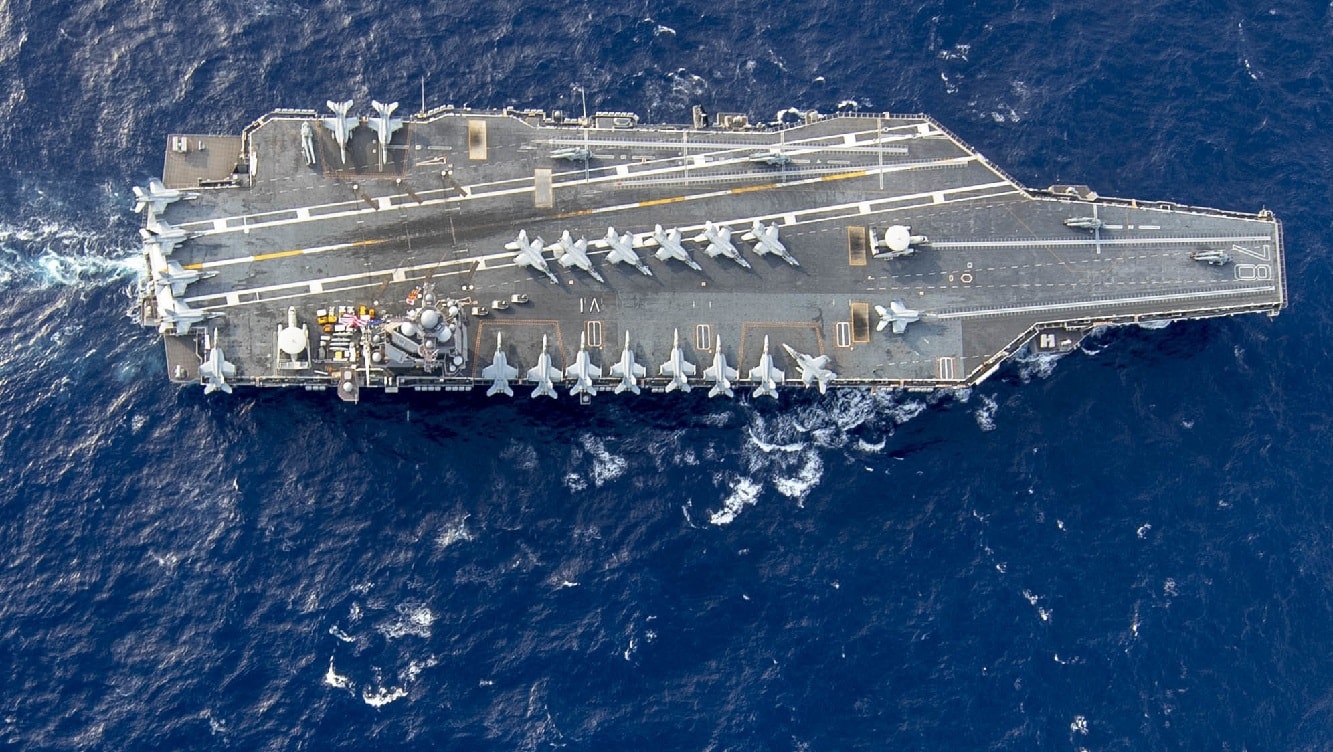At its core, the U.S. Navy is very much a fleet built on the power of the mighty aircraft carrier. That means it should be no surprise that the Navy has built the largest of all aircraft carriers: The US Navy is replacing its aging Enterprise and Nimitz-class aircraft carriers with the most expensive warships ever built – the Gerald R. Ford-class. The Ford has a staggering price tag: $13 billion per unit. The program itself, which incorporates a stunning two dozen novel technologies, has cost $120 billion – a significant mark-up from the estimated $77 billion. The Ford’s price tag is an investment in what should be exceptional performance (and long-term cost saving).
Let’s take a look at what makes the Ford so special and so expensive:
An aircraft carrier’s entire purpose is to project air power off-shore – it’s basically a floating, transportable airfield that can be parked off an enemy’s coast.
So, an aircraft carrier’s effectiveness relates directly to how many flights the carrier can produce. There’s even a metric for this: Sortie Generation Rate (SGR). The Ford-class is slated to produce a 33 percent higher SGR than the Nimitz-class, totalling 160 sorties per day (with the capacity for wartime surges up to 270). To achieve this SGR uptick, the Ford will rely upon the Navy’s newest aircraft launch and recovery technology, namely, the Electromagnetic Aircraft Launch System (EMALS) and the Advanced Arresting Gear System (AAG).
The EMALS replaces the traditional steam piston catapult found on the Nimitz and Enterprise carriers. Using a linear induction motor – which uses electric currents to generate magnetic fields that propel an aircraft along a track – the EMALS is expected to accelerate aircraft more smoothly (thus putting less stress on the airframes) while costing less, weighing less, and requiring less maintenance. Plus, the pivot away from steam-powered pistons will reduce the Ford’s need for freshwater (and the associated, energy-intensive desalination process).
The EMALS will boost the Ford’s SGR because, first, the EMALS recharges more quickly than steam catapults. And second, the EMALS allows for launches with more precise settings, meaning the Ford will be able to launch more kinds of aircraft, from heavy fighter jets, to lighter unmanned vehicles.
The development of the new EMALS system was time-intensive – and very expensive – leading then-President Donald Trump to criticize the system’s cost in an interview with TIME magazine. But, having smoothed out the kinks, the EMALS is now a functional, reliable asset of the initial Ford-class carrier. In fact, the EMALS surpassed 8,000 successful launches and recoveries last May and has even been used to train nearly 400 new naval aviators.
Powering the EMALS is the Ford’s newer, more powerful nuclear reactors. Complementing the EMALS will be the AAG, which is a novel arresting gear, replacing the conventional hydraulic arresting gears found on the Nimitz and Enterprise. Like the EMALS, the AAG will facilitate the use of a broad range of aircraft, including UAVs. The AAG relies on energy-absorbing water turbines, coupled to a large induction motor, which allows for more precise control when arresting aircraft.
Packed with new tech, the Ford has also been designed to cut costs – particularly through decreased manpower requirements.
A Nimitz-class carrier needs a remarkable 5,000 sailors (including airwing staff) to operate. Indeed, personnel is one of the most expensive aspects of carrier operation. So, to reduce operating costs, the Ford has replaced sailors with technology where possible. The result is an estimated 1,100 fewer personnel required to operate the Ford – a 20 percent reduction from the Nimitz. Similarly, the Ford is designed to require less maintenance. With simpler reactors, less-finicky radar systems, and no more steam catapults, the Ford should much be easier – and cheaper – to keep sea-ready. Between the lower maintenance and lower personnel requirements, Ford-class carriers are estimated to save $4 billion in service costs over the course of their 50 year service life.
The Ford’s cost overruns and production headaches are undoubtedly the result of a project so overly ambitious in scope; incorporating so many novel technologies into one new platform was quite bold. Yet, the first-ever Ford-class, launched in 2017, has performed admirably thus far and promises to be the world’s most sophisticated warship for several decades.
Harrison Kass is a Senior Defense Editor at 19FortyFive. An attorney, pilot, guitarist, and minor pro hockey player, he joined the US Air Force as a Pilot Trainee but was medically discharged. Harrison has degrees from Lake Forest College, the University of Oregon School of Law, and New York University’s Graduate School of Arts & Science. He lives in Oregon and regularly listens to Dokken.
This piece has been updated since its publication.

